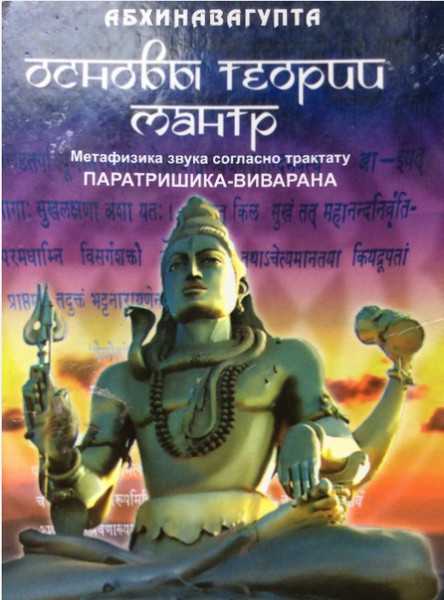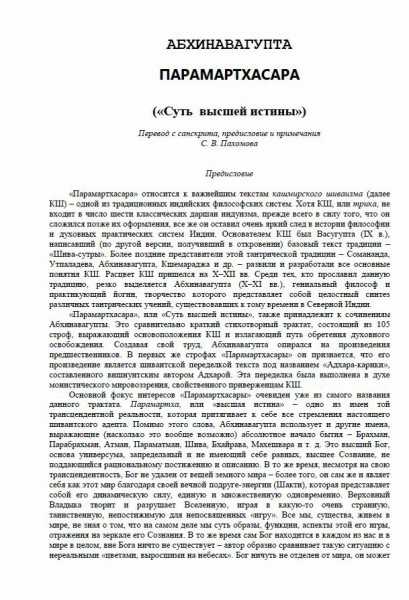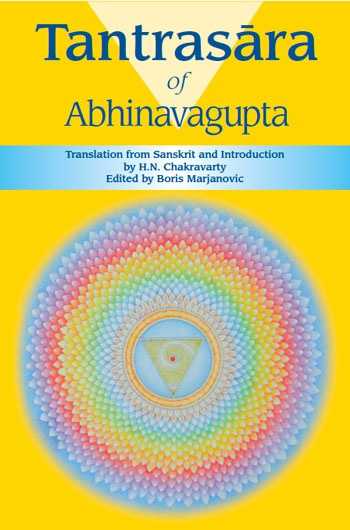ReferencesISBN links support NWE through referral fees
- Abhinavagupta, and Jaideva Singh. 1989. A trident of wisdom. SUNY series in tantric studies. Albany: State University of New York Press. ISBN 0791401804
- Abhinavagupta, and Arvind Sharma. 1983. Gītārthasaṅgraha. Leiden: E.J. Brill. ISBN 9004067361
- Abhinavagupta, and Raniero Gnoli. 1968. The aesthetic experience according to Abhinavagupta. Chowkhamba Sanskrit studies, v. 62. Varanasi: Chowkhamba Sanskrit Series Office.
- Ānandavardhana, Abhinavagupta, and Daniel Henry Holmes Ingalls. 1990. The Dhvanyāloka of Ānandavardhana with the Locana of Abhinavagupta. Cambridge, Mass: Harvard University Press.
- Bansat-Boudon, Lyne, and Kamalesha Datta Tripathi. 2006. The Tantric philosophy of Abhinavagupta the Paramarthasara of Abhinavagupta and its commentary by Yogaraja. London: Routledge. ISBN 041534669X
- Dhar, K. N. 1975. Glimpses of Kashmiri culture. Srinagar: Shri Parmananda Research Institute.
- Isaeva, N. V. 1995. From early Vedanta to Kashmir Shaivism Gaudapada, Bhartrhari, and Abhinavagupta. SUNY series in religious studies. Albany: State University of New York Press. ISBN 0585045763
- Lawrence, David Peter. 1999. Rediscovering God with transcendental argument a contemporary interpretation of monistic Kashmiri Śaiva philosophy. SUNY series, toward a comparative philosophy of religions. Albany, NY: State University of New York Press. ISBN 0585090904
- Muller-Ortega, Paul Eduardo. 1989. The triadic Heart of Śiva Kaula tantricism of Abhinavagupta in the non-dual Shaivism of Kashmir. The SUNY series in the Shaiva traditions of Kashmir. Albany: State University of New York Press. ISBN 0585087369
About Abhinavagupta
ABHINAVAGUPTA lived in Kashmir about the end of the tenth and beginning of eleventh centuries (924-1020 CE).* A versatile genius he injected new meaning into Shaiva Philosophy.
As an original thinker he shattered to pieces the established belief which laid heavy emphasis on caste and gender restrictions in relation to spiritual practice. He took to task those philosophical systems which held the prerequisite that spirituality required rigorous discipline–systems which made the quest for enlightenment the legitimate right of a chosen few. He abhorred the idea that spiritual revelation was only possible in a purely monastic surrounding, or that those caught in the householder way of life had to wait till the last portion of life before they could fully give themselves to spiritual pursuits. This idea was best expressed by Abhinavagupta in one of his concluding verses of Patanjali’s Paramarthasara:
Abhinavagupta’s ideas were radical for his time, but since he spoke from the level of direct experience no one was capable of refuting him.
Having achieved the eight great siddhi powers he clearly exhibited the six illustrious spiritual signs of Rudra Shakti samavesha: unswerving devotional attachment to Shiva; full attainment of mantra siddhi; control over the five elements; capacity to accomplish any desired end; complete mastery over the science of rhetoric and poetry; and the spontaneous dawning of knowledge of all philosophies.
The poet Madhuraja asserted that Abhinavagupta was the incarnation of Bhairava-natha Shiva. Swami Lakshmanjoo considered Abhinavagupta the pride of Kashmir and the final authority on all aspects of Shaivism. Today his works and teachings continue to deeply influence discerning people worldwide.
This website is dedicated to those sincere seekers who wish to take a step on the path of Kashmir Shaivism, and in doing so, come to an understanding of their own divinity. The spiritual flavor (rasa) of Abhinavagupta’s teaching is sprinkled throughout, enlivened by the translations of Swami Lakshmanjoo.
The hymns and texts contained herein are the treasured gifts handed down from generation to generation by the revered masters of the sacred tradition of Kashmir Shaivism.
Om Namah Shivaya!
* Swami Lakshmanjoo was a direct link in the oral tradition of Kashmir Shaiva Masters (sampradaya). On numerous occasions throughout his life he had direct darshan of Abhinavagupta. In a rare personal interview he confirmed that, due to his refined practice of yoga, Abhinavagupta remained healthy throughout his life and lived to the age of ninety-six.
_____________
Above painting of “Abhinavagupta and his two dutis (female attendants), his immediate disciples, Kshemaraja and Yogiraja, along with Swami Ram, Swami Mahatab Kak, and Swami Lakshmanjoo in the foreground”, has been used with permission of the artist: Copyright Claudia Dose.
Книги (3)
 Основы теории мантр. Метафизика звука согласно трактату Паратришика-ВиваранаРаздел библиотеки: Йога
Основы теории мантр. Метафизика звука согласно трактату Паратришика-ВиваранаРаздел библиотеки: Йога
Абхинавагупта — великий индийский мистик и гениальный философ, осуществивший в 10-11 веках н.э. синтез различных течений кашмирского шиваизма. Опираясь на все достижения индийской мистической мысли и тантрической практики, Абхинавагупта вывел философию тантры на новый, поистине высочайший уровень и заслуженно считается непревзойденным классиком индийского мистицизма.За свою жизнь Абхинавагупта написал более 25 сочинений. «Паратришика-виварана» — это одно из наиболее значительных и уникальных его произведений. Центральной темой данного трактата является как Мантра в частности, так и вся метафизика Речи в целом. И это не удивительно, поскольку согласно философии кашмирского шиваизма вся наша Вселенная является выражением и разверткой Паравак (высшей Речи) или трансцендентального Логоса.
Абхинавагупта детальнейшим образом обсуждает эзотерический смысл каждой буквы санскритского алфавита, которые представляют собой различные формы созидающей энергии, порожденной союзом Шивы и Шакти, а также мастерски демонстрирует космогоническую функцию лингвистических правил, тем самым раскрывая сокровенные основы могущества мантры. Книга будет интересна широкому кругу читателей, интересующихся теорией и практикой тантры, а также лингвистам.
Читать »
 ПарамартхасараРаздел библиотеки: Тантра
ПарамартхасараРаздел библиотеки: Тантра
«Парамартхасара» Абхинавагупты — это достаточно короткий текст, кратко резюмирующий его magnum opus, то есть главный тантрический трактат — «Тантралока». Вообще, существует два кратких изложения основных идей школы «Трика», принадлежащих Абхинавагупте — совсем коротенькая «Тантра-вата-дханика» («Tantra-vaṭa-dhānikā») и «Парамартхасара» («Paramārthasāra»), насчитывающая сто пять строф.
В случае с «Парамартхасара» любопытно то, что существовал ещё один текст под тем же названием (несколько более краткий — из 79 или 85 стихов), принадлежавший мудрецу Шешамуни (śeṣamuni, другие имена — Ādiśeṣa, Ādhāra, śeṣanāga), весьма близкий по духу к вишнуитской санкхье; это произведение было весьма популярно в Кашмире в X–XI веках и широко известно также под названием «Адхара-карика» («Ādhāra-kārīkā»).
«Прамамартхасара» была откомментирована Йогараджей (Yogarāja), младшим современником Абхинавагупты, жившим в Кашмире, в Витастапури (Vitastapūri ) во второй половине XI века.
Читать »
 Тантра СараРаздел библиотеки: Тантра
Тантра СараРаздел библиотеки: Тантра
Чистой, нежной защитнице, юной Великой Матери Мира и Отца, чьё тело полно Ею, и пять уст скрывают то, к чему влекутся все, чистым сияющим бытием которых наполнено творение, да озарит мою сущность их бессмертная Кула, превосходящая собою всё!Поскольку всем невозможно постичь «Тантралоку» ввиду её обширности, для этого и сочинена простыми словами эта «Сущность Тантры», которую и следует выслушать.
Читать »
Добавить отзыв
Thought and Works
Abhinavagupta is considered the greatest exegetical theologian of the Shaiva tradition in the medieval period. A prolific and polymathic writer, he is credited with the authorship of as manyas fifty works, only some of which survive to the present day. The two most important philosophical writings were the Parâtrimshikâ-Vivarana and the Tantraloka. Parmarthsara, a philosophical composition of 105 verses, was supposed to be based on the Karikas of Shesha. Other philosophical works were Tantrasara, Gitartha-Sangraha (commentary on the Bhagavad Gita), and Parmarthasara. In addition to his philosophical discussions, he wrote contributed to rhetoric with his commentary on Bharata’s Natya Shastra (Abhinavabharati), poetics with his commentary on Anandavardhan’s Dhvanayloka (the Locana), aesthetics, drama, dance, and linguistics. His work is more of a commentary on and elaboration of existing schools of thought than an original system. He wrote from his personal experience and used reason and logic to explain the meaning of ancient authoritative texts, treating them in a realistic way and making them understandable to the people. In this way he popularized the Pratyabhijna school of Shaivism, which had been introduced by Somananda and Uptala.
In his commentary on the Bhagavad Gita, Gitarthasangraha, Abhinavagupta emphatically declared that freedom from all miseries can be obtained by seeing Him (Paramshiva) in everything and everywhere, and not by renunciation of the world. The impending battle between Pandvas and Kaurvas is interpreted as the race between Vidya (knowledge, perception) and Avidya (ignorance, blurred perception).
The Tantraloka or Light on the Tantras, which appears to have been written after Abhinavagupta had attained enlightenment, is one of the great accomplishments in Indian theology. It weaves together citations from dozens of authoritative scriptures, into a monumental twelve-volume encyclopedic work. The many quotations in the Tantraloka appear to have been cited from memory. Its discourse moves among the realms of rigorous logical philosophy, scripturally-grounded theology, and personal mystical experience. It influenced theological thought and the understanding of the inner meaning of ritual in the Shaiva and Shakta schools for centuries afterward. Tantrasara is a brief prose summary of Tantraloka, which is written in metrical form. Both are based on Malini Vijayatantra, belonging to the Agama school. (The Agamas are believed to be ancient revelations emphasizing the doctrine of liberation through Jnana (knowledge) and Kriya (action).)
Pratyabhijnavimarshini and its larger edition Viviriti belong to the Pratyabhijna (recognition) school of Shaiva Shastra as propounded by Utpala Deva and originated by Somananda. Both Vedanta and Shaivism professed the same goal: «the removal of veil of ignorance.» While in Vedanta the negation of facts of experience was the requirement for realization of the self, Shaivism taught that the self was realized through embracing the facts of experience and recognizing itself in every aspect of the universe. Abhinavagupta defined the term «Pratyabhijna» as: “Recognition of that supreme self is by coming face to face with what was forgotten through effulgence (of consciousness).” Abhinavagupta explained cognition as taking place “when the past perception and the present perception are revived (by the object coming in full view).» Ahbinavagupta explains the apparent contradiction between unity and plurality by saying that in essence, objects are internally one consciousness, but externally, at the illusory level, they are differentiated by physical characteristics.
Among Abhinavagupta’s contributions to aesthetics is his analysis of eight types of rasa (the emotional experience of poetry or drama). He explored how the appreciation of art, music, poetry and literature was heightened by the removal of moha (ignorance), and how their beauty was enhanced through knowledge of Brahman.
Contemporary pânditas and spiritual personages recognized Abhinavagupta as the spiritual head of all the Shaiva schools and as an incarnation of Bhairava (Shiva) himself. On the authority of contemporaneous writers whose works have survived, Abhinavagupta apparently showed all the signs of a fully realized master: he demonstrated unswerving devotion to Shiva; possessed the mantra-siddhi or power of mantras; had control over the elements; was capable of fulfilling any desire; and had spontaneous knowledge of all the scriptures.”
Credits
New World Encyclopedia writers and editors rewrote and completed the Wikipedia article
in accordance with New World Encyclopedia standards. This article abides by terms of the Creative Commons CC-by-sa 3.0 License (CC-by-sa), which may be used and disseminated with proper attribution. Credit is due under the terms of this license that can reference both the New World Encyclopedia contributors and the selfless volunteer contributors of the Wikimedia Foundation. To cite this article click here for a list of acceptable citing formats.The history of earlier contributions by wikipedians is accessible to researchers here:
Abhinavagupta history
The history of this article since it was imported to New World Encyclopedia:
History of «Abhinavagupta»
Note: Some restrictions may apply to use of individual images which are separately licensed.


































